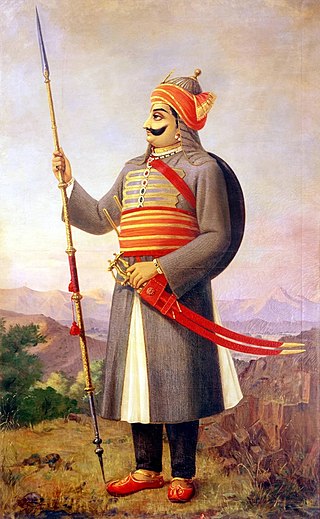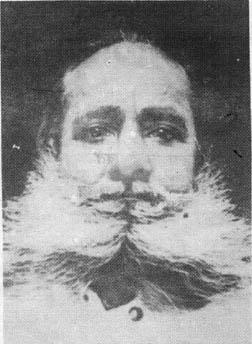Related Research Articles

Pratap Singh I, popularly known as Maharana Pratap, was a king of Kingdom of Mewar, in north-western India in the present-day state of Rajasthan. He is notable for leading the Rajput resistance against the expansionist policy of the Mughal Emperor Akbar including the Battle of Haldighati and the Battle of Dewair.

All India Kisan Sabha, is the peasant or farmers' wing of the Communist Party of India, an important peasant movement formed by Sahajanand Saraswati in 1936.
Thakur Kesari Singh Barhath was an Indian revolutionary leader, freedom fighter, and educator from the state of Rajasthan. He was the patriarch of the Barhath family, members of which participated in anti-British activities Barhath was also known as Rajasthan Kesari.

Vijay Singh Pathik, popularly known as Rashtriya Pathik, was an Indian revolutionary. He was among the first Indian revolutionaries who lit the torch of freedom movement against British rule. Much before Mohandas K. Gandhi initiated the Satyagrah movement, Pathik experimented during the Bijolia’s Kisan agitation. After being implicated in the Lahore conspiracy case in 1915, he changed his name to Vijay Singh Pathik. His grandfather's sacrifice in the struggle of 1857 in Bulandshahr district, affected him deeply to be freedom fighter.
The Begun farmer's movement was one of the farmer's movements of Rajasthan during British Raj in India. Begun is a village in Chittorgarh district. It was a movement of peasants against high taxes by then Mewar government.
The Bijolia movement was a peasant movement in the Bijolia jagir of the former Mewar state against excessive land revenue exactions. Originating in the former jagir of Bijolia, the movement gradually spread to neighbouring jagirs. Leadership to the movement was provided, at different times, by Fateh Karan Charan, Sadhu Sitaram Das, Vijay Singh Pathik, and Manikyalal Verma. The movement continued till 1941 after a bitter struggle lasting about half a century, gained national attention and resisted state oppression.

Gopal Prasad Sharma is an internationally recognised Indian artist associated with the traditional miniature art of Rajasthan.
Ajabde Panwar, popularly known as Maharani Ajabde, was the queen of Kingdom of Mewar. Ajabde is the chief consort and first wife of Maharana Pratap, and the mother of Amar Singh I. She was known for her beauty, intelligence and influence in Pratap's life.
Samantaraja was an Indian king belonging to the Chahamana dynasty of Shakambhari. He ruled parts of present-day Rajasthan in north-western India.

Vigraharāja IV, also known as and also Visala-deva was a king from the Chahamana (Chauhan) dynasty in north-western India, and is generally considered as one of the greatest rulers of the dynasty. He turned the Chahamana kingdom into an empire by subduing the neighbouring kingdoms of Chaulukya, Naddula, and Tomara kingdoms. He also repulsed Muslim invasions, from the Ghaznavid ruler Bahram Shah and defeated Khusrau Shah.
The Berwa, also called Bairwa are a caste found in Rajasthan.They have so many lands,as they are known as zamindar. They falls under Farmer sub-group but along with agriculture they are also involved in house, building, construction as wide contractor.

Motilal Tejawat , (1885–1963) was the leader of the Eki Movement that was agitated in the 1920s in the adivasi-dominated border areas of present-day Rajasthan and Gujarat.
The beginning of the Eki Movement is generally attributed to the events at the Matrikund fair in Chittod. Here, a group of adivasis agreed to desist from paying taxes to jagirdars until the Maharana addressed the problems with the jagirdari system.

Govindgiri, also known as Govind Guru Banjara, (1858–1931) was a social and religious reformer in the early 1900s in the tribal border areas of present-day Rajasthan and Gujarat states in India. He is seen as having popularized the Bhagat movement, which was first started in the 18th century.
Ram Pande was an Indian historian and civil servant.
Fateh Karan Charan was an early 20th-century Indian revolutionary and poet from Rajasthan. He led the Bijolia Peasant Movement in its early stage in the Mewar region of British India.
Narayani Devi Verma was a freedom fighter from Rajasthan in the Indian independence movement. She was the wife of fellow freedom fighter Manikya Lal Verma and together they fought with colonial, imperialist as well as feudal oppression in the erstwhile princely state of Mewar. She had played a key role in the Bijolia movement and also took many steps to promote women’s education. While she was very active in the Praja Mandal Movement, her commitment to Gandhian ideals resulted in her active efforts towards tribal welfare and Dalit upliftment. Even after independence, she remained active in both politics and social service. She was a Rajya Sabha member from 1970 to 1976. She died on 12 March 1977.
Nanak Bheel was an Indian freedom fighter from the Bundi district in the Indian state of Rajasthan. He played a pivotal role in Indian Independence movement in Bundi during British colonial rule in India and lost his life for the cause.
Pandit Nayanuram Sharma also known as Nainuram Sharma was an Indian freedom fighter from Kota, Rajasthan. He played a significant role in the Indian independence movement, contributing to various revolutionary activities and inspiring many in the region.
References
- 1 2 3 David Hardiman, The Nonviolent Struggle for Indian Freedom, 1905-19, Oxford University Press, (2018), p.118, ISBN 9780190920678
- 1 2 Kanakk, Atul (October 11, 2020). "Bijolia's resonance" – via www.thehindu.com.
- ↑ Kanhaiyalal Sharma. Caste, Class, and Social Movements, Rawat Publications, (1986) p.124, ISBN 9788170330301
- ↑ David Hardiman, The Nonviolent Struggle for Indian Freedom, 1905-19, Oxford University Press, (2018), p.118, ISBN 9780190920678
- ↑ Sharma, Brij Kishore (1990). Peasant Movements in Rajasthan, 1920-1949. Pointer Publishers. ISBN 978-81-7132-024-0., p.78
- ↑ Sharma, Brij Kishore (1990). Peasant Movements in Rajasthan, 1920-1949. Pointer Publishers. ISBN 978-81-7132-024-0.
- ↑ Pande, Ram (1974). Agrarian Movement in Rajasthan. University Publishers (India).
- ↑ Pande, Ram (1974). Agrarian Movement in Rajasthan. University Publishers (India)., p.24
- ↑ Sharma, Brij Kishore (1990). Peasant Movements in Rajasthan, 1920-1949. Pointer Publishers. ISBN 978-81-7132-024-0., p.80